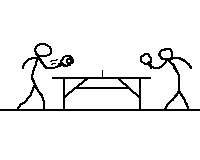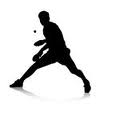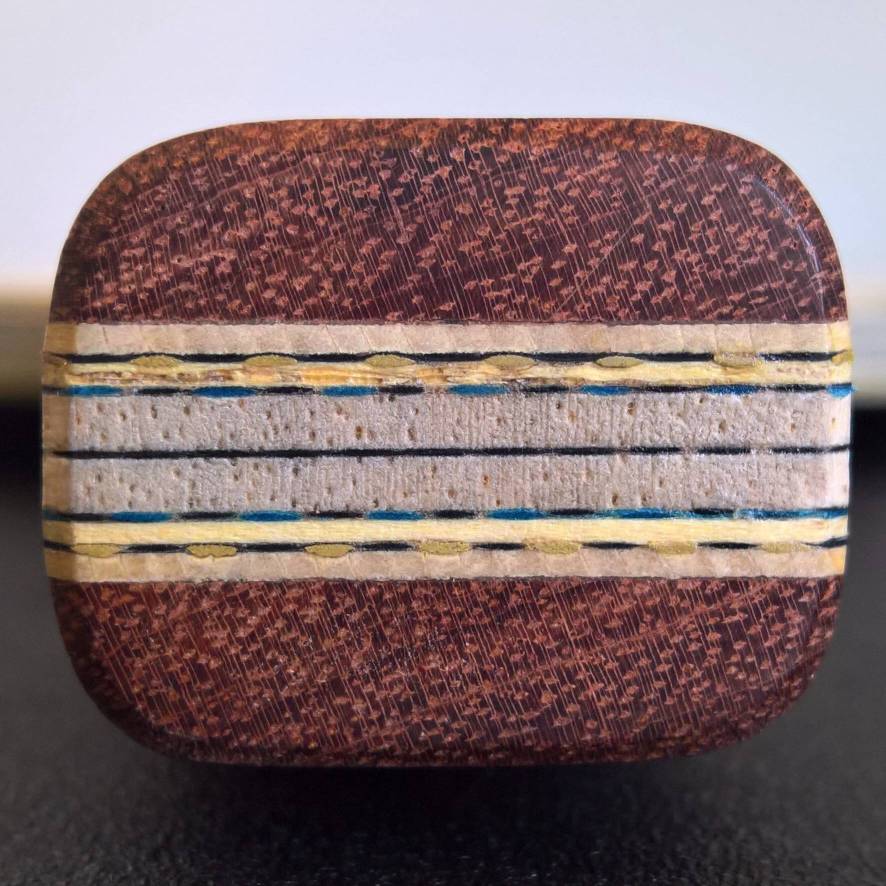|
|
|
Would this theory work in TT? |
Post Reply 
|
Page 123 5> |
| Author | |||||
jrscatman 
Premier Member 
Joined: 10/19/2008 Status: Offline Points: 4585 |
 Post Options Post Options
 Thanks(0) Thanks(0)
 Quote Quote  Reply Reply
 Topic: Would this theory work in TT? Topic: Would this theory work in TT?Posted: 10/25/2013 at 12:18am |
||||
|
Came across this while learning some Badminton? Would this theory work in TT to generate more power in shots?
|
|||||
|
Butterfly MPS
FH: Donic Acuda S1 BH: Palio CK531A OX |
|||||
 |
|||||
| Sponsored Links | |||||
 |
|||||
tt4me 
Gold Member 

Joined: 01/17/2013 Location: RC Poverty Zone Status: Offline Points: 1019 |
 Post Options Post Options
 Thanks(0) Thanks(0)
 Quote Quote  Reply Reply
 Posted: 10/25/2013 at 12:31am Posted: 10/25/2013 at 12:31am |
||||
|
The stopping has nothing to do with it. It is all due to paddle or racket speed at impact.
In TT you twist your body using your legs and waist, this adds to the arm speed and finally the paddle speed. |
|||||
 |
|||||
jrscatman 
Premier Member 
Joined: 10/19/2008 Status: Offline Points: 4585 |
 Post Options Post Options
 Thanks(0) Thanks(0)
 Quote Quote  Reply Reply
 Posted: 10/25/2013 at 12:15pm Posted: 10/25/2013 at 12:15pm |
||||
|
After some thought, I am thinking what he's saying has merit. Also, the fact the man was world champion doubles player in 1980.
I think it's the same principle behind archery - where they draw the bow and hold it - they don't release it right away - don't know the physics - but time to do some research I guess. I will try it on TT tonight see if I can apply it.
|
|||||
|
Butterfly MPS
FH: Donic Acuda S1 BH: Palio CK531A OX |
|||||
 |
|||||
AcudaDave 
Gold Member 

Joined: 11/02/2010 Location: Indiana Status: Offline Points: 1859 |
 Post Options Post Options
 Thanks(0) Thanks(0)
 Quote Quote  Reply Reply
 Posted: 10/25/2013 at 12:54pm Posted: 10/25/2013 at 12:54pm |
||||
|
This is similar to what I tell my son and some of my students when they are looping. It's more powerful if you stop for just a moment on the backswing and then snap through the loop rather than just 1 continuous motion where they never stop.
|
|||||
|
Joola Zhou Qihao 90 blade
Joola Dynaryz Inferno max - BH Nittaku Moristo SP 2.0 - FH |
|||||
 |
|||||
BMonkey 
Gold Member 

Joined: 11/28/2008 Status: Offline Points: 1015 |
 Post Options Post Options
 Thanks(0) Thanks(0)
 Quote Quote  Reply Reply
 Posted: 10/25/2013 at 12:58pm Posted: 10/25/2013 at 12:58pm |
||||
|
Well, we already do this in TT. As best we can anyways since it is a faster sport (how often do you have to sit there and stare at the ball, then restart and hit it?). This can best be seen by the general migration of players to more compact strokes that have more "snap" to them.
Old way: New way:
|
|||||
 |
|||||
tt4me 
Gold Member 

Joined: 01/17/2013 Location: RC Poverty Zone Status: Offline Points: 1019 |
 Post Options Post Options
 Thanks(0) Thanks(0)
 Quote Quote  Reply Reply
 Posted: 10/25/2013 at 1:17pm Posted: 10/25/2013 at 1:17pm |
||||
I would buy the more "snap" but not the pause. More "snap" equates to more speed. More pause doesn't. |
|||||
 |
|||||
BMonkey 
Gold Member 

Joined: 11/28/2008 Status: Offline Points: 1015 |
 Post Options Post Options
 Thanks(0) Thanks(0)
 Quote Quote  Reply Reply
 Posted: 10/25/2013 at 1:30pm Posted: 10/25/2013 at 1:30pm |
||||
|
|||||
 |
|||||
V-Griper 
Silver Member 

Joined: 09/19/2011 Location: United States Status: Offline Points: 879 |
 Post Options Post Options
 Thanks(0) Thanks(0)
 Quote Quote  Reply Reply
 Posted: 10/25/2013 at 2:06pm Posted: 10/25/2013 at 2:06pm |
||||
|
Well the freeze is just a way to orient to the ball, the actual power is generated by small scale whip like kinetic chain.
Here are some examples from other sports. Baseball swing Golf swing The concept of lag is an important one imo. It is really hard to see in tt but the easiest place to see it is in the arms and wrist. However their is also a slight lag in the torso. Some TT examples. Timo forehand- his lag/whip is very noticeable at the elbow as it rotates in first then the forearm then the whip crack at the wrist. Wang Li Qin forehand- Look to the arm again however their is much less bend at the elbow. The lack of bend or the so called straight arm loop has been a source of debate but I do not see the CHN going to a more bent arm. YA being the exception but not the rule. See FZD. Ma Lin forehand- Same Ma Long FH/BH- look to the wrist on the backhand but you also need to look at his legl/torso. You can see him make a motion like his is starting to sit down in a chair then suddenly decides to stand up again. That motion slightly precedes the the upper torso, arm and wrist. Zhang Jike backhand- You can look to his upper back. Does a sort of body roll with his upper back to help produce a whip like motion then transmits that to his arm, wrist, blade. Just for fun here is a dance clip- She is not trying to transmit any force to an object so it's not quite the same, just trying to illustrate propagating a wave through the body. Edited by V-Griper - 10/25/2013 at 2:09pm |
|||||
|
DHS 301
Xiom Vega 7pro FH/BH |
|||||
 |
|||||
jrscatman 
Premier Member 
Joined: 10/19/2008 Status: Offline Points: 4585 |
 Post Options Post Options
 Thanks(0) Thanks(0)
 Quote Quote  Reply Reply
 Posted: 10/25/2013 at 2:49pm Posted: 10/25/2013 at 2:49pm |
||||
|
V-Griper - thanks for all the videos - haven't had a chance to go through them all yet - but the baseball and golf ones were very interesting.
Another thing mentioned by the badminton coach (Dr. Lee Jae Bok) was hitting and pulling back - he said this gives more power than moving through the shuttle - I'll try and find the video. I thought this was also interesting and counter intuitive.
|
|||||
|
Butterfly MPS
FH: Donic Acuda S1 BH: Palio CK531A OX |
|||||
 |
|||||
tt4me 
Gold Member 

Joined: 01/17/2013 Location: RC Poverty Zone Status: Offline Points: 1019 |
 Post Options Post Options
 Thanks(0) Thanks(0)
 Quote Quote  Reply Reply
 Posted: 10/25/2013 at 4:38pm Posted: 10/25/2013 at 4:38pm |
||||
The pulling back after impact doesn't help with the speed either. |
|||||
 |
|||||
ZApenholder 
Premier Member 
Joined: 03/04/2012 Location: . Status: Offline Points: 4804 |
 Post Options Post Options
 Thanks(0) Thanks(0)
 Quote Quote  Reply Reply
 Posted: 10/25/2013 at 5:58pm Posted: 10/25/2013 at 5:58pm |
||||
|
The stop in badminton and "stop" in table tennis is different
The stop in TT is more like stepping towards the ball and putting weight on your right knee (for right handers), and getting the back swing ready to accerate forward with waist rotation. I won't call that stop, I will call that step. Also remember, badminton is a up right motion and coming down towards the ball, very differnt to TT, unless you want to compare going for incoming lobs. |
|||||
 |
|||||
yogi_bear 
Forum Moderator 

Joined: 11/25/2004 Location: Philippines Status: Offline Points: 7219 |
 Post Options Post Options
 Thanks(0) Thanks(0)
 Quote Quote  Reply Reply
 Posted: 10/25/2013 at 9:09pm Posted: 10/25/2013 at 9:09pm |
||||
|
tony, i think they do that on smashes against balls that were lobbed and bounced high. i dont think it is applicable in on the rise loops or loop drives.
|
|||||
|
Independent online TT Product reviewer of XIOM, STIGA, JOOLA, SANWEI, GEWO, AIR, ITC, APEX, YASAKA and ABROS
ITTF Level 1 Coaching Course Conductor, ITTF Level 1 Coach |
|||||
 |
|||||
ZApenholder 
Premier Member 
Joined: 03/04/2012 Location: . Status: Offline Points: 4804 |
 Post Options Post Options
 Thanks(0) Thanks(0)
 Quote Quote  Reply Reply
 Posted: 10/26/2013 at 8:50am Posted: 10/26/2013 at 8:50am |
||||
yeah, and thinking about it, in TT there is more shoulder and back behind the shot for lobs than oppose to just arm and wrist motion. |
|||||
 |
|||||
jrscatman 
Premier Member 
Joined: 10/19/2008 Status: Offline Points: 4585 |
 Post Options Post Options
 Thanks(0) Thanks(0)
 Quote Quote  Reply Reply
 Posted: 10/27/2013 at 3:23am Posted: 10/27/2013 at 3:23am |
||||
|
Thanks everyone for your thoughts, much appreciated. I am still trying to conduct some tests to see if I can figure it out for myself - sadly, my technique in TT & Badminton needs quite a bit of improvement.
|
|||||
|
Butterfly MPS
FH: Donic Acuda S1 BH: Palio CK531A OX |
|||||
 |
|||||
jrscatman 
Premier Member 
Joined: 10/19/2008 Status: Offline Points: 4585 |
 Post Options Post Options
 Thanks(0) Thanks(0)
 Quote Quote  Reply Reply
 Posted: 10/29/2013 at 12:33am Posted: 10/29/2013 at 12:33am |
||||
Tried this and it adds power. Makes a big difference.
|
|||||
|
Butterfly MPS
FH: Donic Acuda S1 BH: Palio CK531A OX |
|||||
 |
|||||
josepher 
Beginner 
Joined: 11/03/2013 Location: usa Status: Offline Points: 14 |
 Post Options Post Options
 Thanks(0) Thanks(0)
 Quote Quote  Reply Reply
 Posted: 11/03/2013 at 7:40pm Posted: 11/03/2013 at 7:40pm |
||||
|
The "theory" of the post is correct, and, as so, the physical basis behind it is extensible to any accelerated motion in any sport or physical activity. Acceleration is a change in velocity or direction of a moving or stationary body, and, as such, requires a force.
There must be an output of energy (force) to change the velocity or direction. Whatever activity we're speaking of, badminton, table tennis, baseball, chopping wood, pushing a car, there is an action we variously refer to as windup, coil, backswing, etc., the purpose of which is to prepare our bodies to function in the most efficient way to achieve the acceleration. Starting a backswing requires energy, but, and this is the key point, so does stopping it! If one attempts to reverse a backswing too fast (continuously, without any sense that it has come to a stop - however short) the energy on the way forward will be lessened because too much energy will be expended in the reversal. An example: You're at a carnival trying to ring the bell. Imagine swinging that very heavy sledgehammer over your head and bringing it down without the slightest delay. That's all it takes to sense the extra energy required. It should be said that all good athletes instinctively know how to use their bodies in the more efficient manner (the stop before the reversal...however short!), because the differences are easily felt. This is merely the physical explanation for it, for those interested. |
|||||
 |
|||||
tt4me 
Gold Member 

Joined: 01/17/2013 Location: RC Poverty Zone Status: Offline Points: 1019 |
 Post Options Post Options
 Thanks(0) Thanks(0)
 Quote Quote  Reply Reply
 Posted: 11/03/2013 at 10:54pm Posted: 11/03/2013 at 10:54pm |
||||
Wrong.
Right
What? You are talking as if one stroke is going to max our our energy. Where is your proof?
Again you assume we are energy limited.
You assume there is time to stop. Look at the recent Schlager video where shows a kid smooth motion without stopping. It is obvious you don't know the difference between energy and power. The old significant thing to having more speed after impact is the racquet or paddle speed at impact if mass and incoming speed is constant. |
|||||
 |
|||||
josepher 
Beginner 
Joined: 11/03/2013 Location: usa Status: Offline Points: 14 |
 Post Options Post Options
 Thanks(0) Thanks(0)
 Quote Quote  Reply Reply
 Posted: 11/04/2013 at 1:29am Posted: 11/04/2013 at 1:29am |
||||
|
Let's get a technical detail out of the way. There is no possibility of continuous motion as backswing changes to forward swing. At the changeover point the velocity of the object being moved is zero...stopped. Small point.
What we're talking about is the degree to which energy is wasted in overcoming too abrupt a changeover. Energy that could be going into the forward motion has been used to halt the backward motion. Example: A baseball infielder or a quarterback making a hurried toss can still snap the ball off pretty good, but not as fast as when the time pressure is off. Example: A hurried table tennis stroke can produce plenty of speed, but not as much as when the time pressure is off. Now, understand, I'm talking about the same length backswings in these examples. When the time pressure is off, the transition (changing the direction from back to forth) is more drawn out and capable of producing more forward power (or energy...same thing). If you are running a race in this direction <, will you be able to take off faster from a still start, or when you are going this way > and have to reverse yourself in this direction < with what seems like a continuous motion? Last example: You're tossing a very heavy ball, say as heavy as a shot put. Would you go back and forth with your arm in what seems like a continuous motion, or gather yourself at the transition?
|
|||||
 |
|||||
stiltt 
Assistant Admin 

Joined: 07/15/2007 Location: Location Status: Offline Points: 1012 |
 Post Options Post Options
 Thanks(0) Thanks(0)
 Quote Quote  Reply Reply
 Posted: 11/04/2013 at 2:18am Posted: 11/04/2013 at 2:18am |
||||
|
Maybe the video in the op is just a teaching trick for people to visualize and separate the components of the stroke; then of course when the student understands and applies the trick (s)he will take advantage of the momentum of the back swing to partially feed the swing itself, like in a tennis serve.
A good analogy is the follow through after a fh (or a bh ) in tt: we can imagine a stiff person who at the end of the swing has the paddle going down to speed 0; it has then to come back from speed 0 to ready position before another back swing; then at the end of the back swing the paddle goes down to speed 0 again; and here starts the swing from speed 0...what a waste of energy! If the follow through + recovery follows an elliptical pattern then some energy from the swing is recycled to bring the paddle back and the energy invested to do so is itself partially recycled into doing the next back swing at the end of which the paddle never stops moving before the swing: the body does it all and makes sure the arm/paddle never lose its momentum. We can imagine a coach separate all those moves and make the student understand each of them separately before having him/her connect all of them into a fluid routine. I think that's what the video in the op does. |
|||||
 |
|||||
JacekGM 
Platinum Member 
Joined: 02/17/2013 Location: USA Status: Offline Points: 2356 |
 Post Options Post Options
 Thanks(0) Thanks(0)
 Quote Quote  Reply Reply
 Posted: 11/04/2013 at 11:42am Posted: 11/04/2013 at 11:42am |
||||
|
This is a good thread, thanks jrscatman... although there is some danger of running into the "dwelltime" syndrome, if you know what I mean...
fatt, I wouldn't say the intention in the video clip was to show phases of the stroke; the guy emphasized that the interruption is necessary for added power... in badminton. He no doubt knows what he is talking about... I think the original clip is very interesting, VGriper has given some excellent examples/analysis as far as applicability of the "stop and then hit" concept to TT, thanks. josepher (  ) I feel this time you are correct, good thoughts, thanks for sharing... ) I feel this time you are correct, good thoughts, thanks for sharing...Finally, IMHO it seems that there are rare cases when this concept of stopped stroke might increase the effectiveness of the shot. However, our sport is so different than badminton, the shuttle-racket interaction is very different than ball-racket interaction... good to keep the concept in mind, though. |
|||||
|
(1) Juic SBA (Fl, 85 g) with Bluefire JP3 (red max) on FH and 0.6 mm DR N Desperado on BH; (2) Yinhe T7 (Fl, 87 g) with Bluefire M3 (red 2.0) on FH and 0.6 mm 755 on BH.
|
|||||
 |
|||||
tt4me 
Gold Member 

Joined: 01/17/2013 Location: RC Poverty Zone Status: Offline Points: 1019 |
 Post Options Post Options
 Thanks(0) Thanks(0)
 Quote Quote  Reply Reply
 Posted: 11/04/2013 at 3:25pm Posted: 11/04/2013 at 3:25pm |
||||
No he doesn't. If he waited an extra 10 milliseconds would he generate more power? What about 1 millisecond or 20 milliseconds? The answer is he would NEED to generate more power because he would need to accelerate the racquet to the same speed in less time to get the same shuttle speed after impact. The energy required would be about the same if the same racquet speed is obtained over different periods of time. That does not mean the speed after impact is higher. Another point is the just because one can generate power doesn't mean it is used efficiently. As I said above I personally would rather listen to Schlager about smooth motion as seen in a recent video. This makes sense. Now the question is what is meant by power? Most on this forum use the term incorrectly but if it is meant to mean a faster speed after impact then the badminton expert is flat out wrong. The only thing that matters is the racquets and paddle speed at impact. One can start the swing earlier and accelerate slower but as long as the same racquet speed is obtained the results will be the same. The power required is less but then it is required for a longer time so the energy required will be about the same. In industry smooth motion is very important because jerky motion causes wear and tear. Jerky motion also requires a higher peak energy requirement that sometimes increases the cost of machinery. If the same result can be achieved with smoother motion then that is the efficient and cost effective way to go. So there is this badminton 'expert' and Schlager that are saying different things. Choose. I choose Schlager. |
|||||
 |
|||||
jrscatman 
Premier Member 
Joined: 10/19/2008 Status: Offline Points: 4585 |
 Post Options Post Options
 Thanks(0) Thanks(0)
 Quote Quote  Reply Reply
 Posted: 11/04/2013 at 3:55pm Posted: 11/04/2013 at 3:55pm |
||||
|
Welcome JacekGM,
I find various sports offer insights into other sports - badminton has been giving me a lot insights into wrist action. Strangely most of my self taught concepts appear to be incorrect. I always thought smooth consistent motion is the correctway - but stopping the motion does offer added power in TT at my level anyways. There have been some really good arguments put forth by others in this thread - just need time to digest it and experiment. I guess we will all end up using what works for us.
|
|||||
|
Butterfly MPS
FH: Donic Acuda S1 BH: Palio CK531A OX |
|||||
 |
|||||
tt4me 
Gold Member 

Joined: 01/17/2013 Location: RC Poverty Zone Status: Offline Points: 1019 |
 Post Options Post Options
 Thanks(0) Thanks(0)
 Quote Quote  Reply Reply
 Posted: 11/05/2013 at 12:04am Posted: 11/05/2013 at 12:04am |
||||
It is. In industry one always tries to make motion as smooth as possible. It reduces wear and tear on machinery. It will reduce wear and tear on you too. Smooth motion requires less energy and that is important in reducing operating costs. The big advantage of smooth moves is that is requires a significantly lower peak power which means machines can be designed with lower cost components.
No. You have no justification or proof for this statement. I can provide plenty of proof that smooth motion is more efficient but I doubt few could understand the math. Baal may be able too. Larry Bavley, Heavyspin, can. Isn't the recent video of Schlager showing the kid how to move smoothly good enough? |
|||||
 |
|||||
jrscatman 
Premier Member 
Joined: 10/19/2008 Status: Offline Points: 4585 |
 Post Options Post Options
 Thanks(0) Thanks(0)
 Quote Quote  Reply Reply
 Posted: 11/05/2013 at 12:46am Posted: 11/05/2013 at 12:46am |
||||
I am interested in learning more about this subject - would you be able to provide a link to the proof?
|
|||||
|
Butterfly MPS
FH: Donic Acuda S1 BH: Palio CK531A OX |
|||||
 |
|||||
tt4me 
Gold Member 

Joined: 01/17/2013 Location: RC Poverty Zone Status: Offline Points: 1019 |
 Post Options Post Options
 Thanks(0) Thanks(0)
 Quote Quote  Reply Reply
 Posted: 11/05/2013 at 1:47am Posted: 11/05/2013 at 1:47am |
||||
The question I have is how good is your knowledge of physics and math? I find it hard to make a case when no one understands physics or the math required to understand physics. Most don't know the definition of power and neither does that badminton player. It maybe more efficient to try to get somebody like Larry Bavly or perhaps Ben Bednarz to verify my math. Larry Bavly or Heavyspin has more TT creds than I do and I think he knows a lot about math because he likes a lot of advanced math topics on YouTube. Ben has told me he has a PhD in physics but if so he has been very silent when it comes to physics topics on this forum. However, this I can assure you right off the top of my head because I have come across these problems so many times. The only thing that matters to the speed after impact is the speed of impact not the time it takes to accelerate to the speed. That badminton 'expert' could make his stroke over 50ms or 100ms and the results would still be the same if the speed at impact is the same. This means the pause makes no difference. If you accelerate something from the same starting speed to the same ending speed it will take the same amount of energy. However, if you accelerate in a short time it will take more power. I consider this to be a "well duh" sort of information. Any racer can tell you that. When making a point to point move the power goes up with the inverse of the time cubed and that is if everything else is perfect. This means if you move from point A to point B in 0.5 seconds it will take 8 times the power it takes to move from point A to point B in 1 second. This is because it take energy or power to stop a mass that is moving. This point was correctly made early on but the magnitude of the power requirements was not. The power requirements stump many. Often I/we get a system to work and the first thing the customer wants is to go 5% or 10% faster not realizing that going 5% faster requires 1.05^3 times more or almost 16% more power. What I don't believe, actually know for a fact, is that pausing for 10 milliseconds or 20 milliseconds is going to make any difference in ones ability to accelerate the paddle over one stroke when a paddle weighs so little. I do agree it will make a difference over time because there will be more stress on the muscles and more energy will be expended. My broken wrist is beginning to hurt. |
|||||
 |
|||||
APW46 
Assistant Moderator 
Joined: 02/02/2009 Location: United Kingdom Status: Offline Points: 3331 |
 Post Options Post Options
 Thanks(0) Thanks(0)
 Quote Quote  Reply Reply
 Posted: 11/05/2013 at 5:01am Posted: 11/05/2013 at 5:01am |
||||
|
It is correct for TT when powering into a dead/passive/slow ball, If a player is in position and prepared to execute the stroke, I teach to hold the trigger, it aids timing and enables a player who is advanced enough to delay and change their intended direction, Its always preferable if time allows, but the reason is not necessarily for increased power (although sweeter timing helps)
In badminton the shuttle decreases in momentum rapidly allowing the opportunity more frequently, but also plays a big part in the deceit of depth ( drop shot or power) In TT its time dependant, if you have no time, you can't do it, and if the incoming ball has pace and spin, you can 'borrow the power' anyway, modern attacking glue effect rubbers are designed for this, so power coming in means less power needed going out, ie same pace and spin but with a slower arm, leading to greater consistency and accuracy.
|
|||||
|
The Older I get, The better I was.
|
|||||
 |
|||||
TTFrenzy 
Super Member 

Joined: 03/16/2012 Location: Greece Status: Offline Points: 369 |
 Post Options Post Options
 Thanks(0) Thanks(0)
 Quote Quote  Reply Reply
 Posted: 11/05/2013 at 8:01am Posted: 11/05/2013 at 8:01am |
||||
|
The "stopping" or "step back" or whatever you wanna call it is nothing more than, storing energy and then releasing it by snaping your whole weight like a whiplash transfering weight from your back leg to your front leg and guiding this "stored" energy using your legs waist forearm and wrist.
The bigger the backswing the more energy stored the more energy released. Any mistake in timing causes unsychronized transfer of energy thus a crappy stroke Case closed ggthanxbye :)
|
|||||
 |
|||||
TTFrenzy 
Super Member 

Joined: 03/16/2012 Location: Greece Status: Offline Points: 369 |
 Post Options Post Options
 Thanks(0) Thanks(0)
 Quote Quote  Reply Reply
 Posted: 11/05/2013 at 8:13am Posted: 11/05/2013 at 8:13am |
||||
The most accurate post I have read in here, most of the posters have a misconception of how physics and energy works. Of course if the ball comes really fast and spinny and you are close to the table its pointless to stop and make a backswing, better borrow the incoming energy and counterhit/block/spin it back. But adding energy to a dead ball either energy in form of spin or speed or both, needs a "steping back backswing" When learning a stroke, stoping and backswinging is essential for correct timing as you said and to somehow help your brain to "automate" the stroke. |
|||||
 |
|||||
Krantz 
Super Member 
Joined: 05/14/2009 Location: Poland Status: Offline Points: 276 |
 Post Options Post Options
 Thanks(0) Thanks(0)
 Quote Quote  Reply Reply
 Posted: 11/05/2013 at 8:23am Posted: 11/05/2013 at 8:23am |
||||
|
It reminds me the situation when you want to have a quick start in your car - first you press the gas pedal to increase engine's RPM and then you suddenly release the clutch (if this applies to manual transmission only, then sorry Americans :P). You probably waste a lot of gasoline(and power) during this preparation phase , but overall it does its job. I can imagine that with a bit of practice you can also store this energy in your muscles for the sudden release (you need it at the exact time when the ball has reached your striking zone) , but personally I don't see much use for this concept in TT, because I'm always restraining myself anyway. Still, an interesting idea.
|
|||||
 |
|||||
APW46 
Assistant Moderator 
Joined: 02/02/2009 Location: United Kingdom Status: Offline Points: 3331 |
 Post Options Post Options
 Thanks(0) Thanks(0)
 Quote Quote  Reply Reply
 Posted: 11/05/2013 at 10:46am Posted: 11/05/2013 at 10:46am |
||||
It is pretty advanced to hold the backswing whilst moving into position/on to the incoming ball, intermediate players tend to commit to the contact fully and start their swing too early when re-looping away from the table, I always suggest keeping the stroke 'tidy' and using a 'locked on' guide to timing the stroke, ie start the stroke smoothly and snap late, too many players go for full bat speed from the start of their stroke. Its like trying to swat a fly.
|
|||||
|
The Older I get, The better I was.
|
|||||
 |
|||||
Post Reply 
|
Page 123 5> |
|
Tweet
|
| Forum Jump | Forum Permissions  You cannot post new topics in this forum You cannot reply to topics in this forum You cannot delete your posts in this forum You cannot edit your posts in this forum You cannot create polls in this forum You cannot vote in polls in this forum |
|
Forum Home | Go to the Forums | Forum Help | Disclaimer
MyTableTennis.NET is the trading name of Alex Table Tennis Ltd. |